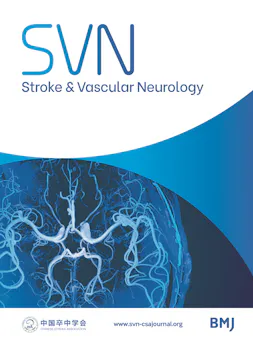无症状颈动脉狭窄与阿尔茨海默氏症和非阿尔茨海默氏症痴呆风险增加有关
IF 4.9
1区 医学
Q1 CLINICAL NEUROLOGY
引用次数: 0
摘要
背景 在没有发生脑血管意外的情况下,无症状颅外颈动脉粥样硬化性疾病(aECAD)是否会影响阿尔茨海默病(AD)和非 AD 痴呆症的风险尚不清楚。了解颈动脉粥样硬化性疾病是否与阿尔茨海默病风险的增加有关非常重要,因为60岁以上的人群中约有10%患有这种疾病,而且这种疾病可能是阿尔茨海默病和非阿尔茨海默病痴呆症的一个可改变的风险因素。方法 这项回顾性队列研究分析了 Mariner 保险索赔。入组标准包括年龄在 55 岁或以上、至少有 5 年数据且未被初步诊断为痴呆症的患者。对患有和未患有先天性痴呆症的受试者进行了后续先天性痴呆症和非先天性痴呆症诊断评估。利用逻辑回归确定的混杂因素进行倾向评分匹配。采用χ2检验和Kaplan-Meier生存曲线来评估随着时间的推移,AECAD诊断对AD和非AD痴呆症风险的影响。结果 767 354 名患者符合入组标准。经过倾向得分匹配后,62 963 名患有 aECAD 的受试者和 62 963 名未患有 aECAD 的受试者通过数据记录得到了跟踪调查。与倾向得分匹配的无艾氏痴呆症患者队列相比,艾氏痴呆症患者队列的艾氏痴呆症相对风险增加了1.22(95% CI 1.15至1.29,p<0.001),非艾氏痴呆症相对风险增加了1.48(95% CI 1.38至1.59,p<0.001)。与aECAD相关的AD风险增加在75岁以下的患者中很明显,而在75岁以上的患者中则不那么明显。结论 aECAD 与罹患 AD 和非 AD 痴呆症的风险增加有关。这些发现强调了进一步前瞻性评估 aECAD 与痴呆症之间相互作用的必要性,这对改变这两个庞大患者群体的临床护理具有潜在影响。如有合理要求,可提供相关数据。本文章由计算机程序翻译,如有差异,请以英文原文为准。
Asymptomatic carotid artery stenosis is associated with increased Alzheimer’s disease and non-Alzheimer’s disease dementia risk
Background In the absence of a cerebrovascular accident, whether asymptomatic extracranial carotid atherosclerotic disease (aECAD) affects Alzheimer’s disease (AD) and non-AD dementia risk is not clear. Understanding whether aECAD is associated with an increased risk for AD is important as it is present in roughly 10% of the population over 60 and could represent a modifiable risk factor for AD and non-AD dementia. Methods This retrospective cohort study analysed Mariner insurance claims. Enrolment criteria included patients aged 55 years or older with at least 5 years of data and no initial dementia diagnosis. Subjects with and without aECAD were evaluated for subsequent AD and non-AD dementia diagnoses. Propensity score matching was performed using confounding factors identified by logistic regression. χ2 tests and Kaplan-Meier survival curves were used to evaluate the impact of aECAD diagnosis on AD and non-AD dementia risk over time. Results 767 354 patients met enrolment criteria. After propensity score matching, 62 963 subjects with aECAD and 62 963 subjects without ECAD were followed through data records. The aECAD cohort exhibited an increased relative risk of 1.22 (95% CI 1.15 to 1.29, p<0.001) for AD and 1.48 (95% CI 1.38 to 1.59, p<0.001) for non-AD dementias compared with the propensity score-matched cohort without aECAD. The increased AD risk associated with aECAD was evident in patients younger than 75 years old and was less apparent in patients over 75 years of age. Conclusions aECAD is associated with an increased risk of developing AD and non-AD dementias. These findings underscore the need for further prospective evaluation of interactions between aECAD and dementia, with potential implications for change of clinical care in both of these large patient populations. Data are available on reasonable request.
求助全文
通过发布文献求助,成功后即可免费获取论文全文。
去求助
来源期刊

Stroke and Vascular Neurology
Medicine-Cardiology and Cardiovascular Medicine
CiteScore
11.20
自引率
1.70%
发文量
63
审稿时长
15 weeks
期刊介绍:
Stroke and Vascular Neurology (SVN) is the official journal of the Chinese Stroke Association. Supported by a team of renowned Editors, and fully Open Access, the journal encourages debate on controversial techniques, issues on health policy and social medicine.
 求助内容:
求助内容: 应助结果提醒方式:
应助结果提醒方式:


